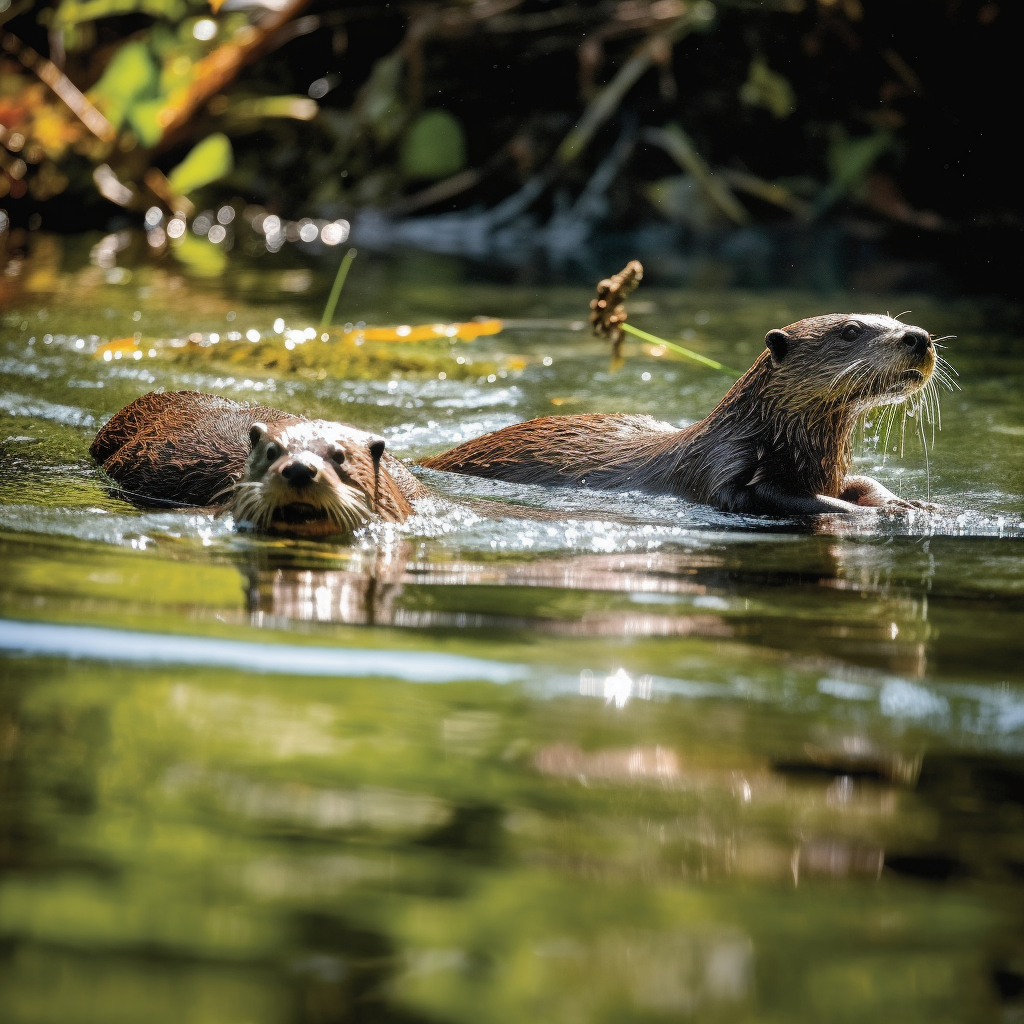River otters are fascinating creatures that can be found in various regions of California. These playful and intelligent mammals are known for their sleek bodies, webbed feet, and long tails, which make them excellent swimmers. River otters are a vital part of the ecosystem, as they help maintain the balance of aquatic environments by controlling populations of fish and other prey species. In this article, we will explore the world of river otters in California, including their habitat, behavior, diet, and conservation status. So, let’s dive in and discover more about these charismatic creatures that call California home.
Key Takeaways
- River otters are a native species in California and play a crucial role in maintaining the health of aquatic ecosystems.
- They are highly adaptable and can be found in a variety of habitats, including rivers, lakes, and coastal areas.
- River otters are skilled hunters and primarily feed on fish, but they also consume amphibians, crustaceans, and small mammals.
- Conservation efforts have helped in the recovery of river otter populations in California, but they still face threats such as habitat loss and pollution.
- Protecting and preserving their habitats is essential for the long-term survival of river otters in California.
The Fascinating World of River Otters in California

A. The North American River Otter in California: An Overview
The North American river otter, a playful and charismatic creature, is a common sight in the waterways of California. These sleek and agile mammals are well-adapted to their aquatic lifestyle, with webbed feet, a streamlined body, and a thick, water-repellent coat that keeps them warm and buoyant in the water.
Characteristics of the North American River Otter
River otters are known for their unique physical characteristics and behaviors. Here are some key features that make them stand out:
-
Appearance: River otters have long, slender bodies that can reach up to four feet in length, including their tail. They have short legs and webbed feet, which allow them to swim swiftly through the water. Their fur is dense and waterproof, ranging in color from brown to dark gray.
-
Habitat: These otters are primarily found in freshwater habitats such as rivers, lakes, and marshes. They are well-suited to both cold and warm climates and can be spotted in various regions across California.
-
Diet: River otters are carnivorous and feed on a diet consisting mainly of fish. They are skilled hunters, using their sharp teeth and strong jaws to catch and consume their prey. In addition to fish, they may also eat amphibians, crustaceans, and small mammals.
-
Behavior: River otters are highly social animals and often live in family groups called “rafts.” They are known for their playful nature, frequently engaging in activities such as sliding down muddy banks, wrestling with each other, and chasing fish underwater. They are also excellent swimmers, capable of diving to great depths and staying submerged for several minutes.
B. The Current State of the California River Otter Population
The California river otter population has faced significant challenges over the years, but conservation efforts have helped to stabilize their numbers. These efforts have focused on protecting their habitats, implementing conservation measures, and raising awareness about the importance of preserving this unique species.
Conservation Efforts and Successes
-
Habitat Conservation: Protecting the natural habitats of river otters is crucial for their survival. Efforts have been made to preserve and restore the rivers, lakes, and wetlands that serve as their homes. This includes reducing pollution, preventing habitat destruction, and creating protected areas.
-
Otter Rehabilitation: In cases where river otters are injured or orphaned, rehabilitation centers play a vital role in their recovery. These centers provide medical care, nourishment, and a safe environment for otters to heal before being released back into the wild.
-
Protection Laws: California has implemented laws and regulations to safeguard river otters and their habitats. These laws prohibit hunting, trapping, and the sale of otter pelts. They also enforce penalties for those who violate these protections.
-
Population Monitoring: Regular monitoring and tracking of river otter populations help scientists and conservationists understand their distribution, abundance, and overall health. This data enables targeted conservation efforts and ensures that the population remains stable.
Despite these conservation efforts, challenges such as habitat loss, pollution, and climate change continue to pose threats to the California river otter population. Continued efforts are necessary to ensure the long-term survival of these fascinating creatures and the preservation of California’s diverse ecosystem.
The Habitats of River Otters in California
River otters are fascinating creatures that can be found in various habitats throughout California. These playful and charismatic mammals have adapted to thrive in both freshwater and marine environments. In this section, we will explore the different habitats where river otters can be found in California and take a closer look at their behavior and characteristics.
A. What Rivers Do Otters Live In?
River otters are primarily found near rivers, streams, and lakes, as they rely on these freshwater sources for their survival. They are excellent swimmers and have streamlined bodies, webbed feet, and a thick, waterproof coat that helps them navigate through the water with ease.
In California, river otters can be spotted in a variety of rivers, including the Sacramento River, San Joaquin River, Russian River, and Klamath River. These waterways provide an abundant food supply and suitable habitats for otters to establish their territories.
B. Freshwater Otters in California: A Closer Look
Freshwater otters in California, also known as North American river otters (Lontra canadensis), are a subspecies of otters that inhabit rivers, lakes, and wetlands across the state. They are highly adaptable and can be found in both urban and rural areas.
These otters have a playful nature and are often seen sliding down muddy banks or engaging in social activities with other members of their family groups, known as rafts. They are skilled hunters and feed on a variety of aquatic prey, including fish, crayfish, frogs, and small mammals.
River otters are known for their intelligence and curiosity. They are excellent problem solvers and have been observed using tools, such as rocks, to crack open shells or break open hard objects. Their playful behavior and agile movements make them a delight to watch for nature enthusiasts and wildlife photographers.
C. The Range of River Otters in Northern California
In Northern California, river otters have a wide range that extends from the coastal areas to the inland waterways. They can be found along the rugged coastline of the Pacific Ocean, as well as in the numerous rivers and lakes that dot the region.
The coastal areas provide an ideal habitat for river otters, as they offer a diverse range of food sources, including shellfish and marine invertebrates. These otters are known to venture into the ocean to hunt for food, but they primarily rely on freshwater ecosystems for their survival.
The conservation of river otter habitats is crucial for maintaining the balance of the California ecosystem. Efforts are being made to protect and restore these habitats, as well as to implement laws and regulations that ensure the well-being of these charismatic creatures.
In conclusion, river otters in California can be found in a variety of habitats, including rivers, lakes, wetlands, and coastal areas. Their adaptability and playful nature make them a beloved species among wildlife enthusiasts. By understanding their habitats and behavior, we can contribute to the conservation and preservation of these remarkable creatures for future generations to enjoy.
Understanding River Otter Behavior and Diet

A. What Do River Otters Eat?
River otters are fascinating creatures that inhabit the rivers, lakes, and coastal areas of California. These playful and agile mammals have a diverse diet that reflects their adaptability to various environments. While their primary source of food is fish, they are opportunistic eaters and will consume a wide range of prey.
In the wild, river otters primarily feed on fish species such as trout, salmon, and catfish. They are skilled hunters, using their sharp teeth and strong jaws to catch and devour their slippery prey. These otters are also known to consume crustaceans, amphibians, reptiles, and even small mammals. Their diet varies depending on the availability of food in their habitat.
River otters are well-suited for an aquatic lifestyle, with their streamlined bodies and webbed feet allowing them to swim swiftly and gracefully underwater. They can hold their breath for several minutes, enabling them to dive deep in search of food. These remarkable creatures are also known to use their sensitive whiskers to detect the movements of prey in the water.
B. Are River Otters Dangerous or Harmless?
River otters are generally harmless to humans and pose no significant threat. They are elusive creatures that tend to avoid human interaction. However, it is essential to remember that they are wild animals and should be observed from a distance.
While river otters are not aggressive towards humans, they may defend themselves if they feel threatened or cornered. It is crucial to respect their space and not approach them too closely. If you encounter a river otter in the wild, it is best to admire them from afar and avoid any sudden movements or loud noises that may startle them.
C. The Interaction Between River Otters and Humans
The interaction between river otters and humans can vary depending on the circumstances. In some cases, river otters may become accustomed to human presence, especially in areas where they have adapted to urban environments. However, it is crucial to remember that they are wild animals and should not be fed or encouraged to approach humans.
In recent years, there has been an increase in otter sightings in California, which is a positive sign for the conservation of these charismatic creatures. Organizations and individuals have been working tirelessly to protect river otter habitats and promote their well-being. It is important to support these efforts and contribute to the preservation of California’s unique ecosystem.
In conclusion, understanding river otter behavior and diet is crucial for their conservation and the preservation of their habitat. By respecting their space, appreciating them from a distance, and supporting conservation initiatives, we can ensure the continued presence of these remarkable creatures in California’s rivers and coastal areas.
The Legal Status and Protection of River Otters in California

A. Are River Otters Protected in California?
River otters are a beloved and iconic species in California, known for their playful nature and sleek appearance. But what is their legal status in the state? Are they protected? The answer is a resounding yes. River otters are protected under both state and federal laws in California.
In 1973, the California Fish and Game Commission classified river otters as a “fully protected” species. This means that it is illegal to hunt, trap, or harm river otters in any way without a special permit. The protection of river otters is crucial for maintaining the balance of the state’s ecosystems and preserving the natural beauty of California’s rivers.
The California Department of Fish and Wildlife (CDFW) is responsible for enforcing these protection laws and ensuring the conservation of river otters. They work tirelessly to monitor and manage otter populations, conduct research on otter behavior and habitat, and implement measures to safeguard their well-being.
B. Can River Otters Be Kept as Pets?
While river otters are undoubtedly adorable and captivating creatures, they are not suitable as pets. In California, it is illegal to keep a river otter as a pet without a special permit. This is because river otters are wild animals with specific needs and behaviors that are difficult to replicate in a domestic setting.
River otters are highly social animals that require large, natural habitats with access to water for swimming and hunting. They have specific dietary requirements and need a varied diet of fish, crustaceans, and other aquatic prey. Additionally, river otters have sharp teeth and claws, which can pose a danger to humans and other pets.
Keeping a river otter as a pet not only goes against the law but also puts the well-being of the animal at risk. It is essential to respect the natural habitat and behavior of these beautiful creatures and appreciate them from a distance. If you encounter a river otter in the wild, consider yourself lucky and enjoy observing their playful antics from afar.
In conclusion, river otters in California are protected by state and federal laws, making it illegal to harm or keep them as pets without a special permit. These laws are in place to ensure the conservation of river otters and maintain the delicate balance of California’s ecosystems. Let’s appreciate these magnificent creatures in their natural habitat and support efforts to protect and preserve their populations for future generations to enjoy.
How to Attract River Otters: A Guide for Nature Enthusiasts
A. Best Practices for Attracting River Otters
If you’re a nature enthusiast and want to catch a glimpse of the adorable river otters in California, there are a few best practices you can follow to increase your chances of attracting these playful creatures to your area. River otters are fascinating aquatic mammals known for their playful behavior and sleek appearance. By creating an inviting environment, you can encourage river otters to visit and potentially even establish a habitat nearby. Here are some tips to help you attract river otters to your location:
-
Provide a Suitable Habitat: River otters thrive in freshwater environments, such as rivers, lakes, and marshes. Ensure that the area you choose has clean water and an abundant food supply, as these are essential for otters’ survival. Creating a healthy ecosystem will not only attract river otters but also benefit other wildlife in the area.
-
Maintain Water Quality: River otters are sensitive to pollution and contaminants in the water. To attract them, it’s crucial to maintain good water quality. Avoid using harmful chemicals or pesticides near the water source, as these can harm the otters and their prey. Additionally, consider participating in local conservation efforts to protect the waterways and ensure the long-term survival of these fascinating creatures.
-
Provide Shelter: River otters need safe and secure places to rest and raise their young. Fallen logs, brush piles, and vegetation near the water’s edge can serve as ideal shelter for otters. By creating or preserving these natural habitats, you can make your area more appealing to river otters.
-
Offer Food Sources: River otters are opportunistic feeders and consume a variety of prey, including fish, amphibians, crustaceans, and small mammals. To attract otters, consider introducing fish species that are native to the area into your water source. This will provide a sustainable food source for the otters and increase the likelihood of their presence.
-
Minimize Human Disturbance: River otters are wary of human activity and tend to avoid areas with excessive noise and disturbance. To attract them, minimize your presence near the water’s edge and avoid making loud noises. Setting up observation points at a safe distance can allow you to observe otters without causing them stress or driving them away.
B. Where to See River Otters in California
California is home to a diverse range of ecosystems that support a healthy population of river otters. If you’re eager to spot these charismatic creatures in the wild, here are some locations in California where you’re likely to have a good chance of seeing them:
-
Monterey Bay: Located on California’s central coast, Monterey Bay is a prime spot for otter sightings. The bay’s rich marine environment provides an abundant food supply for otters, making it an attractive habitat for them. You can often see otters floating on their backs, cracking open shells with rocks, and playing in the kelp forests.
-
Sacramento River: The Sacramento River, which flows through the heart of California, is another excellent place to spot river otters. The river’s clean water and diverse fish population make it an ideal habitat for these playful creatures. Keep an eye out for otters swimming, diving, and frolicking along the riverbanks.
-
Lake Tahoe: Known for its crystal-clear waters and stunning mountain scenery, Lake Tahoe is not only a popular tourist destination but also a haven for wildlife. River otters can be found in the lake and its surrounding rivers and streams. Exploring the quieter areas of Lake Tahoe, away from the bustling tourist spots, will increase your chances of spotting these elusive creatures.
-
Point Reyes National Seashore: Located in Marin County, Point Reyes National Seashore offers a diverse range of habitats, including estuaries, marshes, and coastal areas, which are ideal for river otters. Take a hike along the park’s trails, scan the shoreline, and keep your eyes peeled for otters swimming and foraging in the tidal pools.
Remember, when visiting these locations, always prioritize the well-being of the otters and their habitat. Observe them from a distance and avoid any actions that may disturb or harm them. By following these best practices and visiting the right areas, you’ll have a higher chance of experiencing the joy of observing river otters in their natural habitat.
The Distribution of River Otters Beyond California
A. What States Do River Otters Live In?
River otters are not exclusive to California; they can be found in various states across North America. These playful and charismatic aquatic mammals have a wide distribution range, extending beyond the borders of the Golden State. Let’s explore some of the other states where river otters can be found.
-
Alaska: The pristine wilderness of Alaska is home to a significant population of river otters. With its vast network of rivers, lakes, and coastal areas, Alaska provides an ideal habitat for these semi-aquatic creatures.
-
Washington: The Pacific Northwest is another region where river otters thrive. Washington’s diverse ecosystems, including rivers, lakes, and estuaries, offer ample opportunities for otters to hunt, play, and raise their young.
-
Oregon: Similar to Washington, Oregon boasts a healthy population of river otters. The state’s numerous rivers, such as the Columbia and Willamette, serve as vital corridors for these otters to traverse and establish territories.
-
Idaho: Known for its stunning landscapes, Idaho is also home to river otters. The state’s many rivers, lakes, and wetlands provide an abundance of food and shelter for these playful creatures.
-
Montana: In the Big Sky Country, river otters can be found in various water bodies, including rivers, lakes, and marshes. Montana’s vast wilderness and pristine waterways offer an ideal habitat for otters to thrive.
-
Wyoming: Although not as well-known for its otter population, Wyoming is home to river otters in select areas. The state’s rivers, such as the Snake River, provide a suitable environment for otters to flourish.
-
Colorado: River otters have made a comeback in Colorado after being absent for many years. Thanks to successful reintroduction efforts, these playful creatures can now be found in certain waterways across the state.
-
Michigan: The Great Lakes State is also home to river otters. Michigan’s numerous rivers, lakes, and wetlands provide ample opportunities for otters to find food and establish territories.
B. Comparing California River Otters to Other States
While river otters can be found in various states, the California river otter population holds a special place in the hearts of wildlife enthusiasts. Here are a few factors that make California’s river otters unique:
-
Habitat: California’s diverse landscape, including its rivers, lakes, and coastal areas, provides an ideal habitat for river otters. From the Sierra Nevada mountain range to the Pacific Ocean, otters in California have a wide range of ecosystems to explore.
-
Conservation Efforts: California has implemented robust conservation measures to protect its river otter population. These efforts include habitat conservation, monitoring programs, and public awareness campaigns to ensure the long-term survival of these charismatic creatures.
-
Population Size: California is home to a significant population of river otters. The state’s abundant waterways and suitable habitat have allowed the otter population to thrive, making it one of the largest in the country.
-
Protection Laws: California has enacted strict protection laws to safeguard its river otters. These laws prohibit hunting, trapping, and disturbance of otters and their habitats, ensuring their continued existence in the state.
-
Research and Rehabilitation: California is at the forefront of river otter research and rehabilitation efforts. Scientists and wildlife organizations work tirelessly to study otter behavior, track populations, and rehabilitate injured or orphaned otters, contributing to our understanding of these fascinating creatures.
While river otters can be found in other states, California’s unique combination of habitat, conservation efforts, and protection laws make it a prime location for observing and appreciating these captivating creatures. Whether you’re an avid wildlife enthusiast or simply enjoy spotting wildlife in their natural habitats, California’s river otters are a sight to behold.
Conclusion
In conclusion, river otters in California are fascinating creatures that play a vital role in maintaining the health of aquatic ecosystems. These playful and intelligent animals have made a remarkable recovery in the state, thanks to conservation efforts and habitat restoration. By understanding their behavior, habitat requirements, and the challenges they face, we can continue to protect and conserve these charismatic creatures for future generations to enjoy. Whether you encounter them in the wild or at a local zoo, observing river otters in their natural habitat is a truly memorable experience. So, let’s celebrate the return of these adorable and resilient creatures to California’s rivers and continue to support their conservation efforts.
Frequently Asked Questions
How can I attract river otters to my property?
To attract river otters, you need to provide a suitable habitat for them. This includes access to clean water bodies, such as rivers or ponds, and a plentiful supply of food like fish, amphibians, and crustaceans. However, it’s important to remember that these are wild animals and should not be encouraged to become dependent on humans for food or shelter.
What do river otters eat?
River otters are carnivorous and their diet primarily consists of fish. However, they also eat a variety of other aquatic creatures including amphibians, crustaceans, and occasionally small mammals and birds.
In which rivers can I find otters in California?
River otters can be found in many rivers across California. Some of the most common places to spot them include the Sacramento and San Joaquin Rivers, as well as smaller tributaries and wetlands throughout the state.
What is the status of the river otter population in California?
The exact number of river otters in California is unknown, but their population is believed to be stable or increasing. They are not currently listed as endangered or threatened in the state.
Where can I see river otters in California?
River otters can be seen in a variety of aquatic habitats throughout California. Some popular locations for otter spotting include the Suisun Marsh, the Sacramento and San Joaquin Rivers, and the wetlands of the San Francisco Bay Area.
Are there river otters in California?
Yes, river otters are native to California and can be found in many of the state’s rivers, lakes, and wetlands.
What states in North America are home to river otters?
River otters are found in every U.S. state except Hawaii. They are most common in the Pacific Northwest, the Great Lakes region, and the Atlantic and Gulf Coast states.
Are river otters dangerous to humans?
While river otters are generally not aggressive towards humans, they are wild animals and can defend themselves if they feel threatened. It’s best to observe them from a distance and never attempt to feed or touch them.
Can river otters be kept as pets?
No, it is illegal to keep river otters as pets in California and most other states. They are wild animals and need a specific habitat and diet to thrive.
Are river otters protected in California?
Yes, river otters are protected under California state law. It is illegal to hunt, trap, or harm them in any way. Any suspected violations should be reported to the California Department of Fish and Wildlife.




